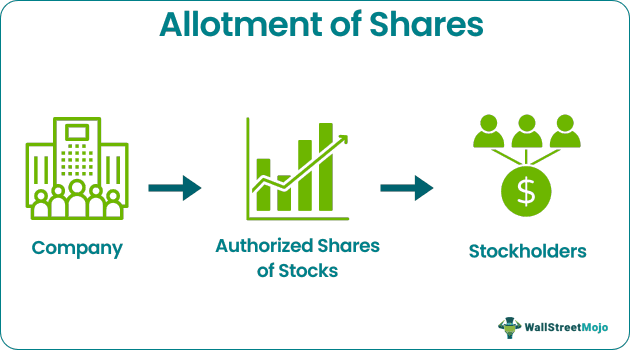Table Of Contents
Process
Allotting shares involves several steps to ensure the smooth issuance and allocation of new shares to investors. Here's a breakdown of the steps involved:
- Authorization and Resolution: The company's board of directors authorizes the issuance of new shares. This is often done through a formal resolution, specifying the number of shares to be issued, the type of shares (common or preferred), and the price at which they will be offered.
- Offer Document Preparation: If the shares are being offered to the public through an initial public offering (IPO) or a secondary offering, the company prepares an offer document (prospectus or offering circular) that contains detailed information about the company, its financials, management, and the terms of the offering.
- Regulatory Approvals: The offer document goes to the regulatory authority for approval. In many jurisdictions, regulatory bodies like the Securities and Exchange Commission (SEC) in the United States must ensure that the information provided is accurate and complete.
- Marketing and Investor Outreach: If the shares are being offered publicly, the company may use marketing efforts to attract potential investors. This can involve roadshows, presentations, and meetings with institutional investors.
- Subscription and Application: Interested investors submit applications to subscribe to the new shares. These applications include the number of shares they wish to purchase and the selling price.
- Allotment Decision: Once the subscription period closes, the company's board of directors reviews the applications and decides how many shares will be allotted to each investor.
- Allotment Letters and Share Certificates: Allotment letters are sent to successful applicants, confirming the number of shares allotted to them and the payment details. Depending on the jurisdiction and the shareholding method, physical share certificates or electronic records are issued to the shareholders..
Types
Some common types of share allotment:
- Public Offering (Initial Public Offering - IPO): In an IPO, a company offers its shares to the general public for the first time. This is when a private company publishes its shares on a stock exchange. IPOs involve significant regulatory compliance and scrutiny.
- Secondary Offering: A secondary offering occurs when a company that is already publicly listed issues additional shares to raise more capital. This is for fund expansion, repaying debt, or other corporate purposes. Secondary offerings can dilute existing shareholders.
- Rights Issue: In a rights issue, existing shareholders have the right to purchase additional shares at a discounted price compared to the current market price. This is a way for the company to raise capital from its existing investor base. It is while allowing them to maintain their proportional ownership.
- Private Placement: Private placement involves offering shares to a specific group of investors, often institutional investors, venture capital firms, or accredited investors. This method is less public and involves fewer regulatory requirements than a public offering.
- Preferential Allotment: Preferential allotment involves issuing shares to a specific group of investors, such as promoters, directors, or strategic investors, at a predetermined price. Thus, this method is best for bringing in strategic partners or rewarding critical stakeholders.
Examples
Let us understand it better with the help of examples:
Example #1
Suppose XYZ Tech Solutions, a cutting-edge technology company, decides to go public through an IPO. The company plans to issue 10 million shares to the public. After obtaining regulatory approval, XYZ Tech Solutions released its prospectus containing information about its products, financials, management, and growth strategy.
During the IPO process, individual and institutional investors subscribe to the shares by submitting applications to purchase a certain number at a specified price. After the subscription period ends, the company's board of directors (BOD) reviews the applications and decides how many claims to allot to each investor. The shares are for the successful applicants who become shareholders of XYZ Tech Solutions and can trade their shares on the stock exchange.
Example #2
SBFC Finance, a financial services company, concluded the crucial step of finalizing the basis of allotment for its IPO shares on August 10, 2023. The IPO garnered substantial investor interest, with the subscription being oversubscribed by a significant margin. This development came after the IPO successfully closed for subscription.
The basis of allotment determination is a critical process in which the company's board reviews the subscription bids and decides the allocation of shares to various categories of investors, including retail, institutional, and non-institutional ones. In addition, this process is based on demand, subscription levels, and regulatory guidelines.
SBFC Finance's IPO offering saw robust demand, reflecting investor confidence in the company's business model and growth prospects. The finalization of the basis of allotment will determine the number of shares allotted to each category of investors.
The financial industry will keenly observe the outcome of this step as it signifies the next phase of the IPO journey. Hence, successful allotment and the subsequent listing could indicate a positive market response to SBFC Finance's public debut.
Importance
Key reasons why the allotment of shares is essential:
- Capital Infusion: Allotment of shares allows companies to raise capital by issuing new shares to investors. This capital is for funding expansion, research and development, acquisitions, debt repayment, and operational improvements.
- Growth Opportunities: By raising capital through share allotment, companies can pursue growth opportunities that might have otherwise been financially out of reach. This can include entering new markets, developing new products, and scaling their operations.
- Diversification of Ownership: Allotting shares increases the number of shareholders, leading to a diversified ownership structure. This can enhance the company's stability by reducing the risk associated with concentrated ownership.
- Liquidity Enhancement: Listing shares on a stock exchange due to allotment provides shareholders a platform to trade their shares. This improves the liquidity of the claims and can attract more investors to the company.
- Strategic Partnerships: Allotting shares can be a way to establish strategic partnerships with other companies or investors. This can lead to collaboration, shared resources, and synergies that benefit both parties.
Frequently Asked Questions (FAQs)
Share allotment benefits employees through Employee Stock Ownership Plans (ESOPs), aligning employee interests with the company's success.
Share allotment is subject to regulatory approval and compliance. Companies must adhere to securities regulations and provide accurate and transparent information to investors.
No, allotment of shares is the issuance of new shares, whereas the distribution of dividends involves paying a portion of profits to shareholders in cash or additional shares.
Regulatory authorities oversee the allotment of shares process to ensure fairness, transparency, and compliance with securities laws. They review offer documents, monitor investor protection, and approve share issuance.


